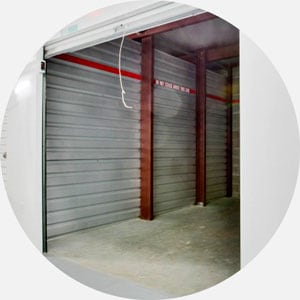Self-Storage Basics: What to Expect
Storage Unit Sizes
Standard units will have a ceiling height of eight feet.
25
Square Feet
Looks like:
Hall closet or half bathroom
What will fit:
Small items, like bags, suitcases and boxes
50
Square Feet
Looks like:
Large walk-in closet
What will fit:
The contents of an average studio apartment
75
Square Feet
Looks like:
Small bedroom
What will fit:
The contents of a small one-bedroom apartment
100
Square Feet
Looks like:
Average bedroom
What will fit:
The contents of a one-bedroom apartment
150
Square Feet
Looks like:
Small one-car garage
What will fit:
The contents of a two-bedroom house or large apartment
200
Square Feet
Looks like:
Standard one-car garage
What will fit:
The contents of a two- to three-bedroom house or full garage
250
Square Feet
Looks like:
One-car garage
What will fit:
The contents of a three-bedroom house
300
Square Feet
Looks like:
Two-car garage
What will fit:
Four to five bedroom house with appliances or a 40 ft. moving van
Storage lockers have ceiling heights ranging from two to five feet (ideal if you’re only storing a few boxes and bags)
Mezzanine units are locker-sized units located above other lockers or full-sized units. They are usually accessed via ladder.
Workspaces are designed for office or commercial use, and unfit for everyday storage. They are often climate-controlled with electrical outlets.
Vehicle Storage
To search for vehicle storage, select 'Vehicle - Covered' or 'Vehicle - Uncovered' in the Amenities drop-down menu.
Outdoor Spaces
A designated parking spot or an unused space on the premises where you can park your vehicle. Outdoor spaces can be covered or uncovered.
Indoor Spaces
Some facilities offer regular storage units for your vehicle. If you go with this option, remember to find a unit with drive-up access. We recommend the sizes listed below.
- Will Fit:
- Motorcycles or very small cars
- Will Fit:
- Vehicles under 15 feet in length
- Will Fit:
- Most average-sized vehicles
- Will Fit:
- Most vehicles, trucks or vans
You should not try to fit your vehicle into a unit with a door less than ten feet wide.
Storage Unit Amenities
A breakdown of the most common amenities offered by storage facilities.
 Climate Control
Climate Control
The facility will maintain a safe temperature and humidity level for your unit. If you’re storing something temperature-sensitive or particularly valuable, climate control is a good idea.
 Drive-Up Access
Drive-Up Access
You can pull your moving truck or vehicle right up to the unit. This is rarely available for indoor units.
 Truck Rental
Truck Rental
Some facilities will let you rent their moving truck for free. Specific terms and restrictions will vary by facility (e.g., mileage limits, time limits, insurance requirements, refueling protocol).
 24-Hour Access
24-Hour Access
You have access to your unit at any time. Restrictions may apply—for example, your facility could require manager approval. Some facilities only allow business customers 24-hour access or may charge additional fees.
 Locks
Locks
Most facilities require you to bring your own lock, although many will sell locks onsite. We recommend closed-shackle padlocks, disc locks or cylinder locks. Standard or combination padlocks are easily picked and not recommended.
 Security
Security
Video camera surveillance, electronic gates and “fenced + lighted” can all increase the security of the facility. A manager who lives onsite means that someone will be on the premises during non-business hours.
Moving In
Making a reservation on SelfStorage.com ensures that the unit will be available when you’re ready to move in.
On move-in day, simply show up at the facility with your confirmation email from SelfStorage.com (pulled up on your phone or printed out) and let them know that you’re a SelfStorage.com customer. Please bring a photo ID and a form of payment. You should also bring a copy of your homeowners insurance or renters insurance, which may save you from paying additional insurance fees.
Depending on whether the facility charges at the first of every month or on your move-in anniversary date, you may need to pay a pro-rated amount for your first month. Other move-in fees may include:
Additional Fees
Insurance: Most facilities require proof of renters or homeowners insurance when you sign your paperwork and move in. You may also have the option to purchase insurance provided at the facility.
Administrative fee: The admin fee is a common storage industry fee that covers the cost of signing up a new tenant.
Security deposit: Some facilities will charge a security deposit upfront. This works in much the same way as a security deposit for an apartment rental.

Moving Out
Please direct all move-out inquiries to your facility when you plan to move out. While storage leases are typically month-to-month, you will be required to give advanced notice of your move-out. Additionally, most facilities will not prorate your rent when moving out. Be sure to coordinate a move-out date with the facility to avoid paying for a full month.
That’s it! On your scheduled move-out day, empty your unit and follow any additional procedures requested by the facility.
Have questions about your storage needs? SelfStorage.com’s team can help—don’t hesitate to get in touch with us!
